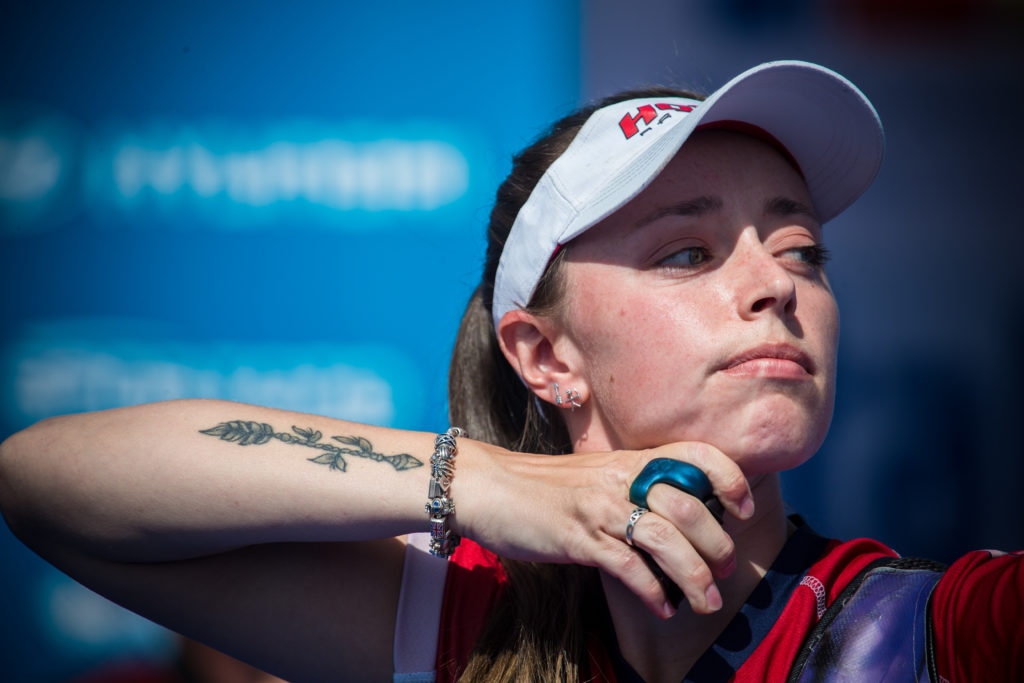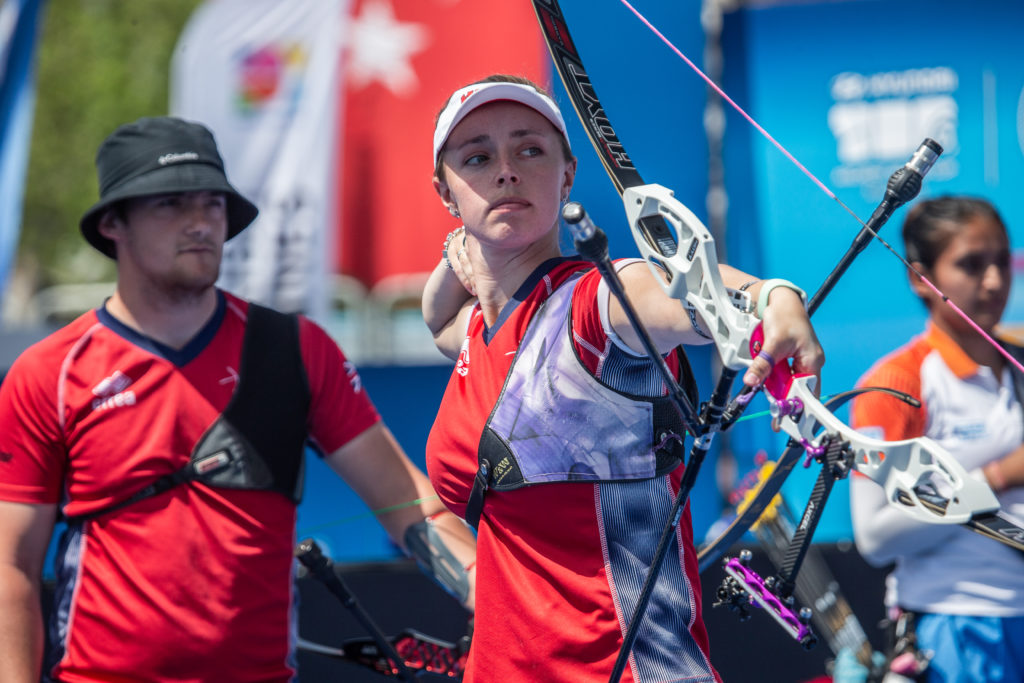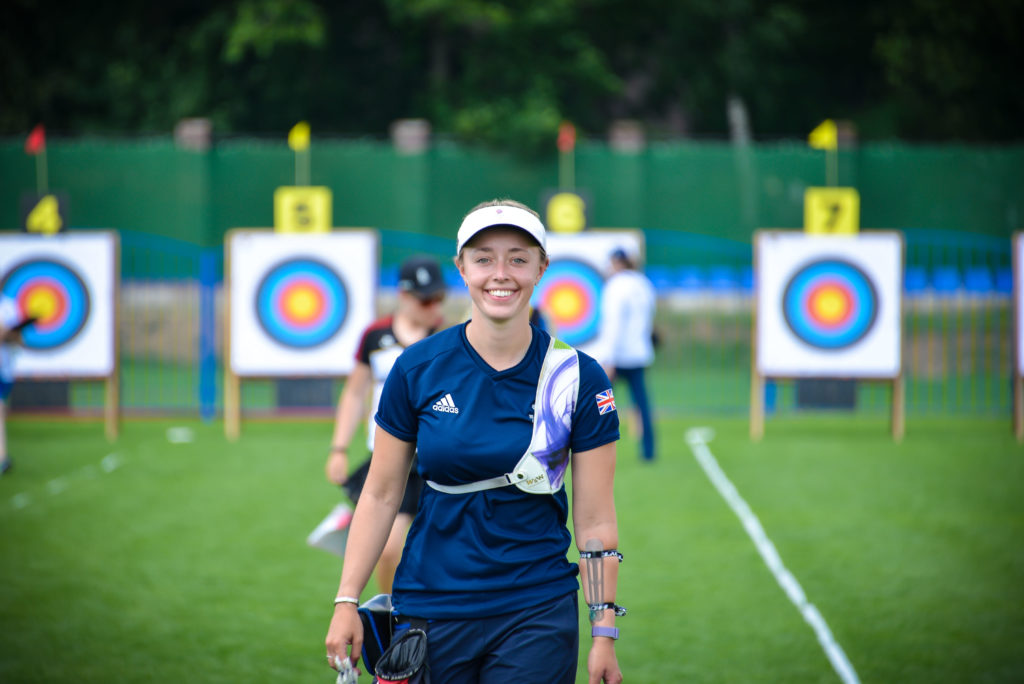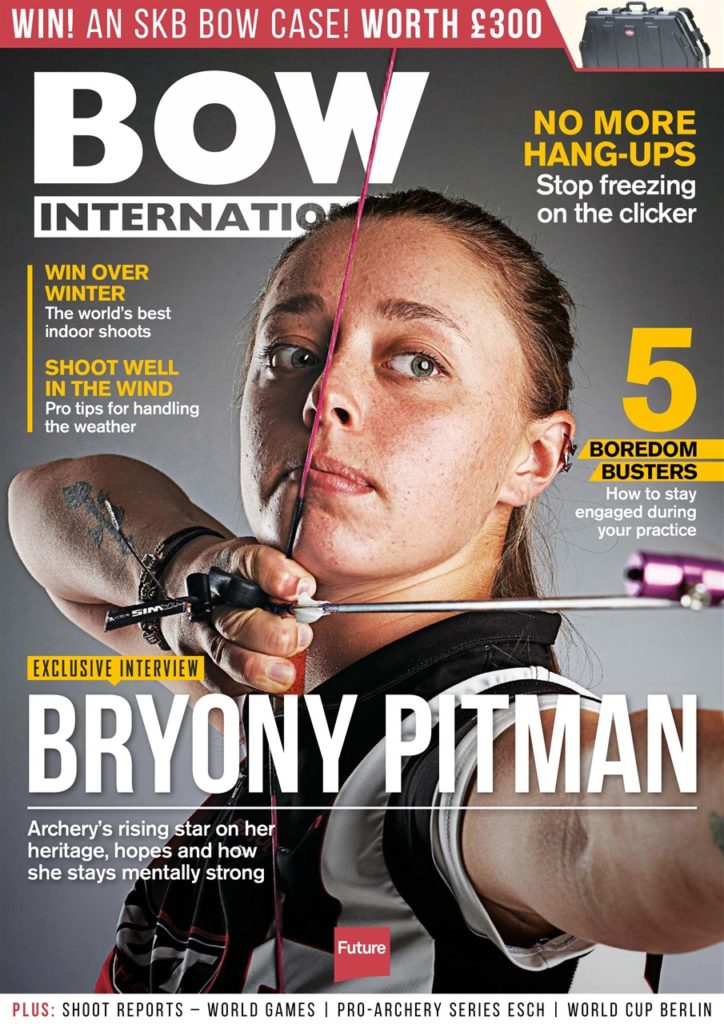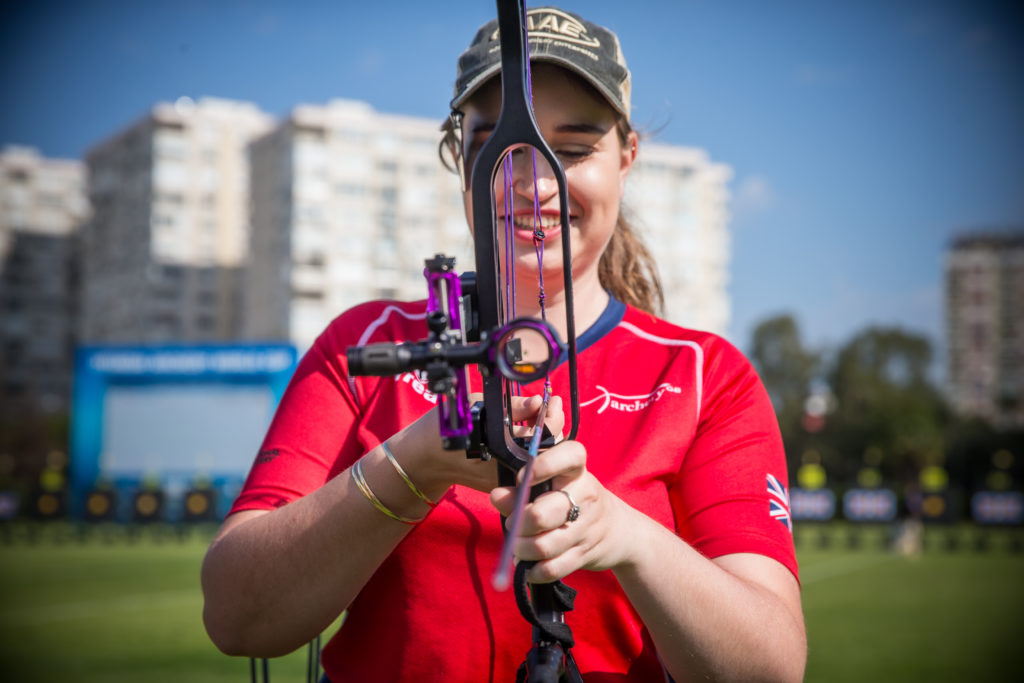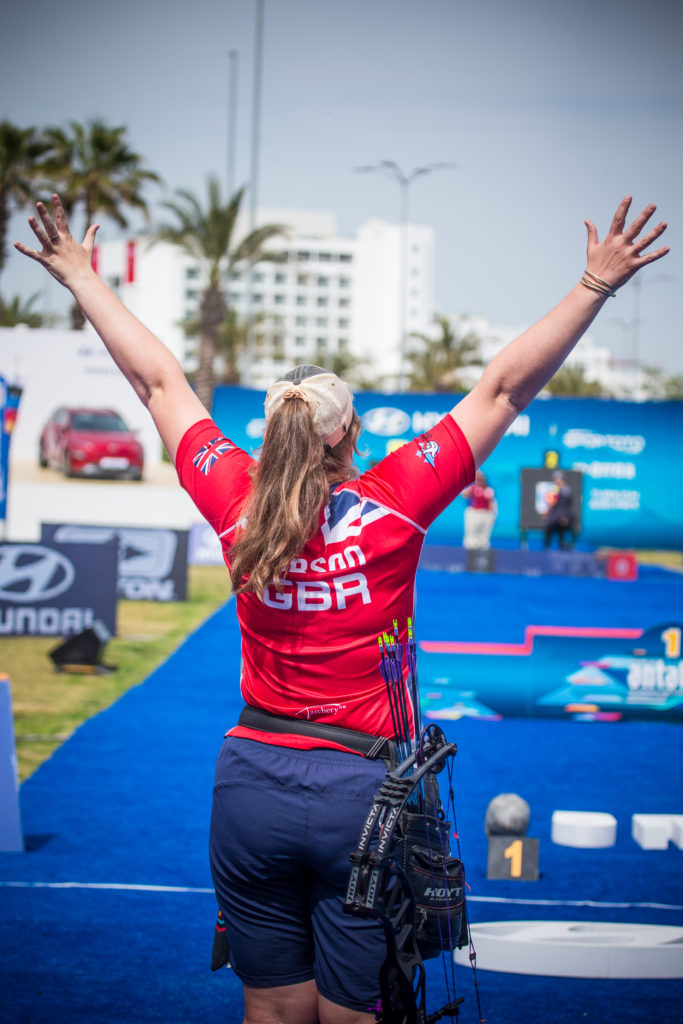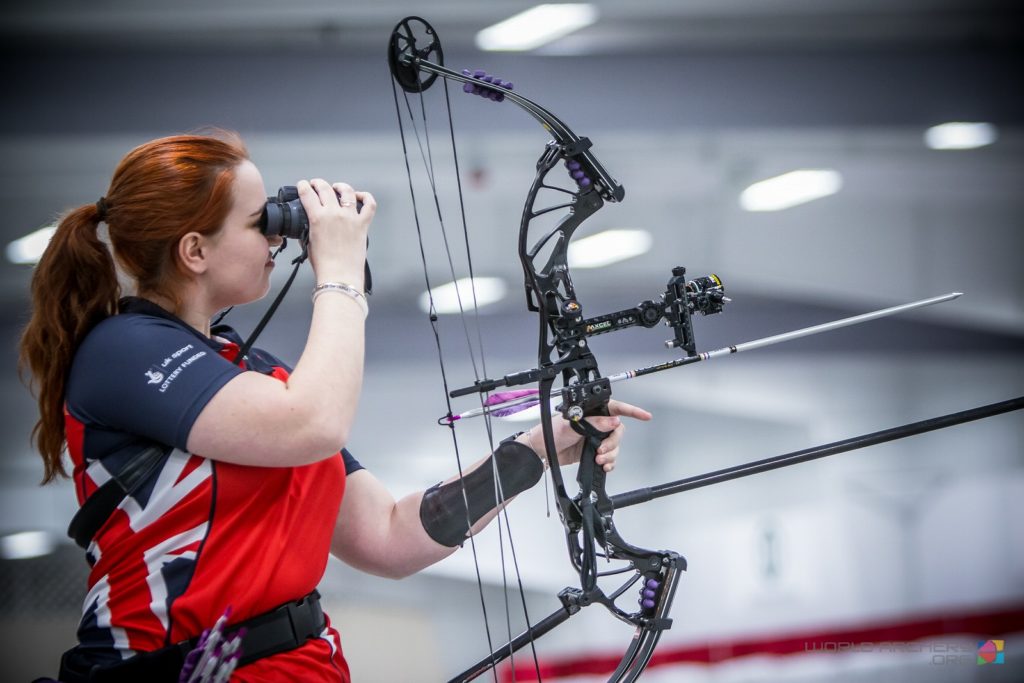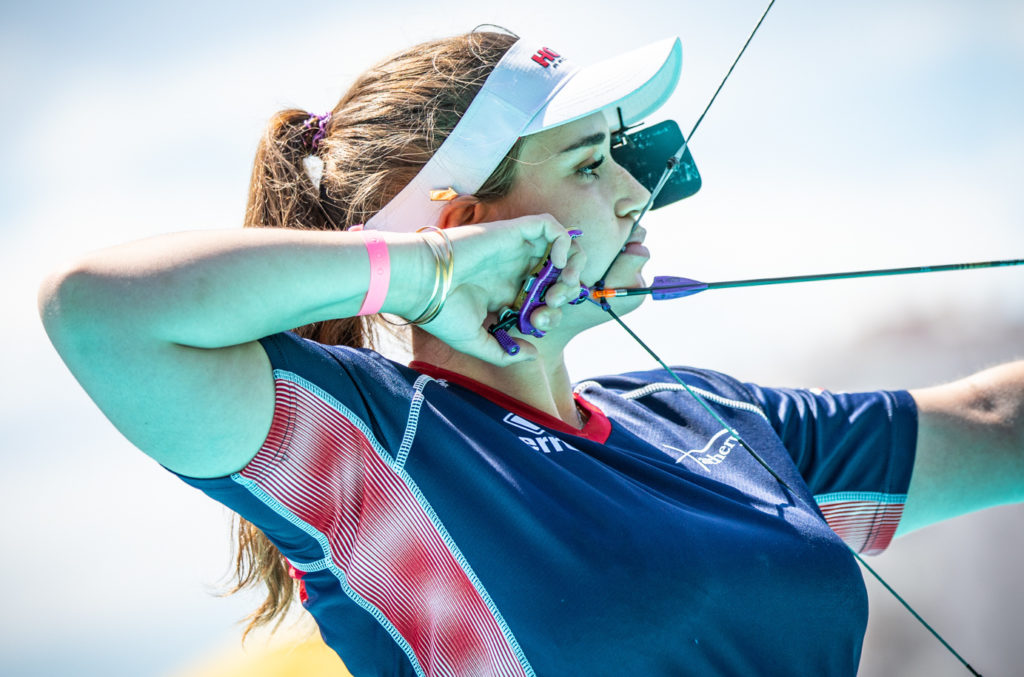Last month’s cover star Bryony Pitman catapulted into the world top 10 after winning an unprecedented three medals at the Antalya World Cup. Now in her 10th year as an international, and still only 25, the future is looking brighter than ever, with people already talking about a renaissance in British recurve. She spoke to Mimi Landström
How did you feel after the team round at the Tokyo olympics?
The team round was disappointing. I’d never experienced nerves like it and I didn’t feel confident in my preparation in the lead up to Tokyo, so that didn’t help me to relax. I didn’t shoot anywhere near what I was capable of and didn’t enjoy the experience at all, especially after a pretty rubbish qualifying round. It was hard because I didn’t understand what was going wrong or how I was going to fix it before the individual rounds.
How did you get up from that?
My teammates were all supportive and we helped each other refocus as best we could. I also called my parents that night and had a good cry. My dad said it was the first time he’d seen me look nervous and uncomfortable at a competition. That’s essentially all that went wrong. I shoot my best when I’m enjoying myself, but I seemed to forget that for the first days of the Olympics. I just thought to myself that I was going to have as much fun in the individual competition as possible. I knew I had a tough bracket. No one expected me to win my first two matches, so I just went and enjoyed it so that I could look back at the games with good memories and lots of valuable lessons learned.
What changes did you make in the winter season?
This winter season was very different for me. Usually I increase my arrow volume over the winter and try to compete indoors regularly, but this time I had to start and finish my Masters dissertation, so that took priority. I made a couple of technique changes straight after the World Championships in Yankton, the biggest being the way I draw the bow. I also dropped my draw weight a lot so that I didn’t have to shoot as much. I needed a mental break from archery, though. It had been tough to continue training a lot between Tokyo and Yankton.
Which of those changes made the biggest difference?
I think dropping my draw weight has been beneficial. I planned to increase the weight again from March but ended up leaving it. I’m slowly getting more confident with it in the wind, relearning how far to aim off and so on, but it’s been a lot easier to power through shots when I’m a bit shaky under pressure. It’s also allowed me to make changes in my technique easily, and I’ve got back into shooting lots because I want to, rather than feeling like I have to in order to maintain bow fitness.
How did it feel to coach in LAS Vegas? What did you do?
I’d rather have been shooting. But honestly, I was happy that Penny Healey asked me to stay with her for the rest of her matches. We had a great match together and I shot well, but Penny was on far better form than me that week and deserved to be on top of the podium.
I’ve seen how hard Penny works and it was incredible to see that effort turn into an amazing result. I was proud of her. I don’t think I did much, I just tried to keep her smiling and said the right things when she needed me to.
I heard the team felt the pressure was off in Antalya. Is that right?
I don’t think that’s 100% true. It wasn’t a milestone event for us, but it was still part of our European Championship trials so we were still all there to perform and had our own expectations.
The difference was more the atmosphere within the team. It was a lot more supportive than it has been previously and so naturally people relaxed more. There have been a lot of changes within our Olympic programme since last October. Antalya provided an opportunity to see how those changes were working and what more needs to be done.
When did you know it was going right in Antalya?
During the second half of qualification. I was strangely nervous during the first half; I think it was just getting back into international events again. I started to have more fun in the second half, my shots flowed better and more went in the middle. I was surprised that I qualified as high as I did with my score, but that gave me confidence for the rest of the week.
How was it competing without a head coach?
I can’t speak for the rest of the team, but for me it was fine. We had an excellent team of staff with us. They gave us opportunities to set goals at the start of the week, debrief as and when we needed, and just said and did what athletes needed them to do during the competition.
For the past few years, I’ve usually had Sarah Smith as my coach at international target events, as has the women’s team, so Antalya was no different for me.
You’ve shown an ability to get over bad arrows in match play recently. How do you do that?
I just didn’t worry about them. It’s easier to get over shots that are obviously terrible. It’s happened, there’s nothing you can do to change it and you’ve probably lost that set, so just forget about it and make the next one a nice, normal shot. That’s the beauty of the set system, you only need to shoot three good sets.
In the past I’ve found it harder to shoot better if I’m hitting eights and nines all the time because it can be more frustrating when it feels fine but they’re just not going in. That’s something I’m still working on, but it just comes down to being confident and relaxed.
How many arrows do you shoot in a week?
At the moment, I shoot around 1,500 to 1,800, depending on competitions. In the two or so weeks leading up to a big event that might drop to about 1,200 to 1,300. The people I train with always keep it fun. My dad gives me random score challenges to win chocolate bars (sadly the 50p-per-10 incentive stopped a long time ago) and my mum’s been helping me focus more on the mental side.
I’ve also started using a training programme from the Online Archery Academy, so that my sessions have more structure and I don’t just turn up to the range and make it up as I go along. I’ve had a lot of good ideas from them about how to make each session more valuable. I train in the gym four to five times per week and run three times per week. I’m trying to start being more consistent with my mental training, too, doing daily affirmations and visualisation.
What does a typical week look like for you?
Monday I go to the gym and run; Tuesday gym and shoot; Wednesday shoot and run; Thursday gym and shoot; Friday gym, shoot and run; Saturday and Sunday shoot or compete. I try to chill out on Mondays or do any bow maintenance, fletching and so on.
You recently had a training camp in Australia. how did that help? How did that differ from being in the UK during the spring?
It was a well-needed mental reset, more of a holiday with my bow. I went to stay with my boyfriend and meet his family since the Australian borders were finally open. I’d just finished university so it was great to go somewhere warm and build my strength and arrow volumes back up without wearing five layers of thermals and getting sore fingers.
I was able to shoot some competitions over there, too, which I couldn’t have done at home. It was nice to shoot competitions without any pressure. I was able to test my bows, different mental routines and build up a lot of trust in myself. The only problem was readjusting to the cold when I got back.
How does it feel to be World Number 5 after the Antalya World Cup?
It feels amazing. During my last few outdoor internationals, I feel I’ve gone from strength to strength and my hard work’s finally starting to show. I’ve still got more to give, though, and improvements are being made, but it’s a great way to start the season.
What’s On Your Bow? Bryony Pitman
RISER: Hoyt Formula Xi.
“I’ve always shot Hoyt and absolutely love their bows. They’re also a great company and shooting for them makes you feel like part of a family. I’ve tried the Xceed but for me the Formula Xi feels a lot smoother to draw, especially the last bit to pull through the clicker.”
LIMBS: Hoyt Velos. 42lbs in medium, 37.5lbs on the fingers.
SIGHT: Axcel Achieve XP, with a Shrewd Flex Recurve Scope and a Clear Targets lens (Green halo for target and orange halo for field)
“I like the Shrewd scope because of its size. I can see so much more of the target, which helps me relax and not over-aim. I shoot the Clear Targets lens with a halo because I don’t get on with dots. In the past, I always found that I would look under the dot so that I could see the middle of the target. With a halo, I can just focus all my attention on the spot where I’m aiming. It also gives me a second reference to subconsciously line the circle up with the target face. I have two different size halos that I can switch between depending on distance, face size, need to aim off and so on. In general, I shoot a medium halo, but can use the small one if I feel like I need to be more precise.”
BUTTON: Wifler Industries MP One Pro.
“I love this button. It’s so easy to use and I like the idea of magnets rather than springs. It doesn’t wear down my arrows at all but also doesn’t get worn down itself, so I don’t have to keep replacing anything on it. I’ve had some great results with it in this past year.”
STABILISERS: Shrewd Revel stabilisers with a 3in REX extender, and a Riot V-bar, 40 degrees out and 10 degrees down.
Long rod is 28in, with a Doinker A-Bomb and 5.5oz of weight on the end.
Short rods are 12in, with a Doinker A-Bomb and 4.5oz on the end of each.
“My current set up feels like it’s well balanced. It allows me not only to aim steady, but also the bow reacts nicely on the follow through.”
GRIP: R-Core Ye0-Lo grip. “I never got on with standard grips because my hands are quite small and the angles were always wrong, which created a lot of tension in my bow hand. The Ye0 grip is perfect for me. The angle of the grip allows me to get my hand (and bow arm) into a strong position so I can put pressure through the centre of the grip, rather than torquing it. A combination of the angle and the material has also stopped me from having any issues with my hand slipping in both rainy and humid conditions.”
CLICKER: W&W carbon clicker (the older version). “I take the metal bit off it because I hate the tinny sound it makes. I also use the screw from a Beiter clicker because it tightens better and looks nice.”
STRING: BCY Mercury, 26 strands. “My dad makes my strings so I get an unlimited amount and it’s easy to test different strands, lengths, and so on. I’ve shot with BCY 8125 and 8190 in the past, but beyond that I’ve not tried anything else.”
TAB: Fairweather tab with the metal pro-plate. “No modifications, it doesn’t need any.
The Fairweather tab is so simple, so nothing can go wrong. It’s by far the best tab I have ever used. It’s incredibly comfy to shoot with and the three layers of leather protect my fingers well. The kangaroo leather gets shot-in quickly, but then lasts for ages.”
“It’s also the first tab I’ve had where I can cycle between three different ones and not be able to tell the difference in feel, grouping or sight mark.”
ARROWS: Easton X10, 600 spine. Eli vanes P2, tungsten points 110g and Beiter over nocks with pins underneath. “For field, I use Easton ACEs to get a bit more speed.”
Interview: Ella Gibson
Ella Gibson has also appeared into the top 10 this year, having only started archery in 2017. This year she took her first major event title, the European Indoor Championships in Lasko, Slovenia, adding an indoor gold to the outdoor silver she took at the European Outdoor Championships a year ago – following that with World Cup gold in Antalya. She also spoke to Mimi Landström
Who have you learned from, and what did you learn?
I have learnt so much from so many different people over the years. I learnt some of my foundations from the coaches at my club – Steph and Dan Gill – and even more elements of my technique from Jon Nott. I have learnt about my kit from so many people like Simon Scott, Shaun Teasdale, James Mason, Greg Poole and others. There isn’t one person that has taught me everything, but rather a huge group effort that has shaped the archer I am. One of the biggest things I have learnt is actually from Simon, Jon and myself. That’s to trust myself and my instincts, and that whenever I do that, I will be successful.
What changes have you made in the past year – in life or archery?
I haven’t really made any changes in life, but I have made some in my shooting. In the past year, I have made some equipment changes, moving from Doinker stabilisers to AAE rods, changing from Easton arrows to Black Eagle arrows and swapping my kisser for a nose button.
You’ve had a lot of family support. It seems all successful archers need some kind of support. would you say that’s right?
Absolutely, my family are amazing and super supportive of my archery. Everyone needs a support system. It doesn’t have to be family, but I do think that you need others who believe in you, that will be there for you.
You avoided lockdowns last year simply by staying in Europe between tournaments. Is that right? How did that feel?
Yes, last year the European Championships were in Turkey. At the time, Turkey was on our red list, meaning if I went I wouldn’t be able to return to the UK without staying in a quarantine hotel for two weeks, which would have meant no practice and a huge cost. I didn’t want to miss the European Championships. Just two weeks after it was the Paris World Cup, which I also didn’t want to miss, so I went to Turkey with one other archer and then stayed in Luxembourg with friends for two weeks. I am super-happy with that decision as I won my first individual senior medal there, silver, as well as my spot to the World Games, which I am attending in a couple of months. It was a tricky thing to do, being away from home for so long, but it was worth it. I had a good two weeks of training before Paris, where we won another silver medal – as a team this time.
Who are you keenest to face in match play and why?
I would like to face Tanja Gellenthien again as I have shot against her a couple times and have yet to win, so I want to keep doing it until I do. There isn’t anyone I am keen to avoid. There are so many great archers out there and I don’t think wanting to avoid anyone will serve you well if you want to win.
How many arrows do you shoot in a week?
It all varies, depending on what I am working on that week. Honestly, it is never the same each week, but generally around 1,000 to 2,000 a week. I also do some gym workouts for strength. I have a S&C coach that writes me personalised programs. This varies depending on where I am in the season. If I need my best performance, then I will reduce or even stop my gym sessions, but when I have some room or preseason, I will do more, normally two to three sessions a week.
What do you think has contributed the most to your current success?
Time. I don’t feel I am shooting better than I have done the past couple of years, but I have a bit more experience now. I’ve had time to get used to how I shoot and trust myself more to make the changes I need when I need them.
You are travelling to America a lot this year for competitions. do you think you will consider moving there if you have the chance?
I don’t know. I will have to see what the future holds. That may be something I will need to do one day, but I think I will just keep travelling a lot and try to be smart in planning my calendar.
Tell us about the win in Antalya? How did you prepare for it? How did it feel after?
I didn’t prepare to win it but I did prepare for it. One of my main preparations was actually going to Arizona Cup a few weeks before, I knew it would be a good warm event to see how I was shooting and how my kit would perform under pressure. I really think it helped by getting those first competition nerves out of the way before Antalya.
I went into Antalya planning on a top eight finish and thought a medal would be a bonus but not a definite. Winning was an amazing surprise for me and, honestly, until the second end of my gold medal match, I was certain that it wouldn’t happen. The moment Alejandra Usquiano dropped a nine, I realised I could do it, that I could actually win, and I am really happy I did what I needed to achieve that.
How will you train ahead of the World Cup Finals? Will you be doing anything different to what you are doing currently?
I have a bit of a gap before the World Cup finals so I plan on going back to the USA for some competitions to keep that high-level pressure up and to do some extra physical prep before it.
What’s On Your Bow? Ella Gibson
Bow: Hoyt Invicta.
Length: 40in.
Poundage: 60lbs and 19lbs holding weight.
Cams: SVX.
Why this set up? “I love the hard wall on the SVX cams, which lets me be aggressive on the back end when I want to without pulling past the stop. I shoot a 40in Invicta as I feel it fits me better than the 37 and is a forgiving bow. In the past year, I have had the privilege of being able to test multiple bows and bow brands. I have found, without a doubt, that this is the best bow and set up for me, giving me the highest scores and best performance under pressure. “
Rest and blade: AAE Freakshow QD with a 10 Freak blade.
Sight: Axcel Achieve XP.
Scope: Axcel AV25 +.
Lens: 0.75.
Dot: 0.8mm fibre.
Peep: Speciality Archery 3/64th.
Clarifier: Green 2 strength.
Why this set up? “The Axcel sight is a truly great sight which has no excess movement or sound. It has a locking system for piece of mind and micro adjustment for moving your sight in addition to looking great. My Axcel scope is perfect for me. Smaller than a standard size scope with a smaller peep gives a more accurate alignment. I use a Feather Vision lens with a drilled hole that has my fibre in it and a green 3/64th clarifier to help make the target a little clearer and be able to aim more accurately.”
Grip: Equilibrium Archery six-degree prototype.
Strings Reign Supreme Bloodline 99.
Release aid: TRU Ball Blade Pro Flex with a custom Matrac Thumb barrel 9mm diameter. “It is set fairly light.”
Stabilisers: AAE Nitrous rods with a 10-degree offset on the front.
Weights: 23oz on long rod
and 21oz on side rod.
Lengths: 30in and 15in.
ARROWS: Black Eagle Revelations, 400 spine, AAE Hybrid 2.0 vanes. Points: Black Eagle Tungsten 120gr. Easton Large G Pin nocks.
“In the past year or so I have changed from shooting a 37in Invicta to a 40in Invicta which I find fits me so much better and is a forgiving bow. I have also changed my side rod from a 12in bar to a 15in bar, which just gives me a slightly different feel in the bow.”
“In addition, I have increased the mass weight on my bow quite significantly from 12oz on my long rod to 23oz, and 16oz on my side rod to 21oz, which makes the bow feel far more stable, especially in windy conditions.”
“I now use a MaTrac thin thumb barrel on my TRU Ball blade release aid, which I absolutely love. It has a good amount of texture that grips onto the skin of your thumb so that you can have a nice relaxed hand position that stretches without your thumb slipping off your barrel which gives a more consistent shot timing to your shot especially during rainy or sweaty days.”


